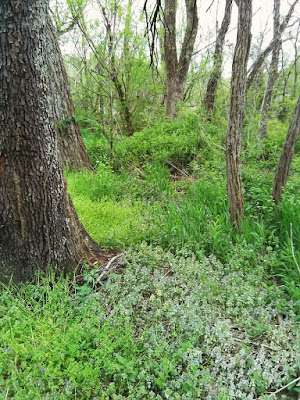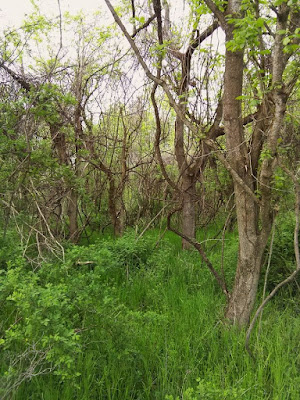 We have passed it by for years, this place of swamps. It is along West Virginia Route 2 between Point Pleasant, that place of Mothman fame and site of the creepy Richard Gere movie, the Mothman Prophecies, and Huntington, home of Marshall University and the site of the excellent movie, We Are Marshall with Matthew McConaughey.
We have passed it by for years, this place of swamps. It is along West Virginia Route 2 between Point Pleasant, that place of Mothman fame and site of the creepy Richard Gere movie, the Mothman Prophecies, and Huntington, home of Marshall University and the site of the excellent movie, We Are Marshall with Matthew McConaughey.  This is a long, mostly straight stretch of road, probably the straightest in the state outside of the interstates, and travels alongside of the Ohio River and the railroad tracks. Route 2 was probably an early Native route and one traveled by frontiersmen and settlers. Today this area is largely rural with a smattering of small factories and plants, but mostly one travels through wheat, corn and produce fields. It's a peaceful, beautiful drive, and our route of choice when Larry needs to go to the Veteran's Administration hospital in Huntington for tests or whatever.
This is a long, mostly straight stretch of road, probably the straightest in the state outside of the interstates, and travels alongside of the Ohio River and the railroad tracks. Route 2 was probably an early Native route and one traveled by frontiersmen and settlers. Today this area is largely rural with a smattering of small factories and plants, but mostly one travels through wheat, corn and produce fields. It's a peaceful, beautiful drive, and our route of choice when Larry needs to go to the Veteran's Administration hospital in Huntington for tests or whatever.  This swampy place I mentioned is called Green Bottom, the name given to it by the Jenkins family, who moved to the area from "old" Virginia and developed a thriving agricultural enterprise here. William Jenkins owned 4900 acres here of good rich river bottomland and even in 1850 the farm was valued
at $80,000. The family (slaveowners with quite a few slaves, unfortunately) produced corn, wheat, barley, sweet potatoes, potatoes, wool and beef and in later years grew tobacco and other crops. I was once told that they also tried to grow rice, which might explain the swamps, but my research has not proved that to be true.
This swampy place I mentioned is called Green Bottom, the name given to it by the Jenkins family, who moved to the area from "old" Virginia and developed a thriving agricultural enterprise here. William Jenkins owned 4900 acres here of good rich river bottomland and even in 1850 the farm was valued
at $80,000. The family (slaveowners with quite a few slaves, unfortunately) produced corn, wheat, barley, sweet potatoes, potatoes, wool and beef and in later years grew tobacco and other crops. I was once told that they also tried to grow rice, which might explain the swamps, but my research has not proved that to be true.Albert Gallatin Jenkins was the son of the founder of this plantation. A Harvard law graduate, he entered the Confederate Army when the Civil War broke out, and left his estate in the hands of his father-in-law. Sadly, Jenkins lost his life in the war, and his estate eventually was divided up amidst much family controversy.
We found a rutted gravel track that led to a parking area and a boardwalk through the wetlands to an observation platform. The walk was almost ethereal, with the lush greens, overhanging vines, and birdsong everywhere. It is unfortunate that the noise of the nearby highway can still be heard but otherwise this is a place apart from the world of man.

Here you can see a beaver dam, and we saw a large beaver lodge as we passed by on the highway--no photo of that, but maybe next time.
We saw several varieties of ducks, some Canada geese, redwing blackbirds and many other birds as we followed the boardwalk. We also heard lots of splashes as little frogs dived underwater at our approach, and the croaking of some bullfrogs that sounded like mighty big fellas.
In this photo, you can just see the Jenkins mansion in the distance. This house was 50 feet long and 25 wide and there were many outbuildings during its heyday. Today only the house remains, and it is slowly being renovated to be a museum, although work on this state project seems to have come to a halt. At one time tours were offered, but now the windows are boarded up and the house is not accessible to the public.
It was such a peaceful place, and I tried to imagine how it might look in early morning, as the mist rises from the river. One day I'd like to see that.
Somewhere under this water are those sneaky little frogs that would not let me see them.
I could barely see the slow trickle of water through this swampy patch, stirring those brown bits that looked to me like larvae of some type.
If you'd like to know more about Green Bottom and its history, I can recommend Archival Research on the History ofthe Albert Gallatin Jenkins HouseGreen Bottom, Cabell County,West Virginia , and excellent and well-researched online document. For more about Albert Gallatin Jenkins and his part in the Civil War, see this article by the West Virginia Division of Culture and History.
Copyright Susanna Holstein. All rights reserved. No Republication or Redistribution Allowed without attribution to Susanna Holstein.







Always a joy to add to the list of "favorite places to visit on the way to occasional destinations"!
ReplyDeleteI always try and spend some time when I visit family graves at Green Bottom Cemetary. Quiet, serene, beautiful. Brings back childhood memories.
ReplyDelete